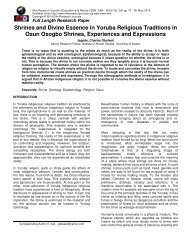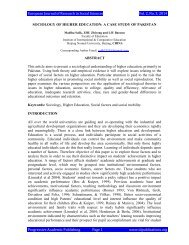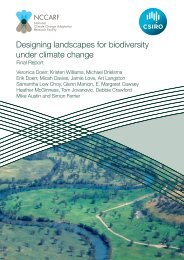Williams-Climate-change-refugia-for-terrestrial-biodiversity_0
Williams-Climate-change-refugia-for-terrestrial-biodiversity_0
Williams-Climate-change-refugia-for-terrestrial-biodiversity_0
You also want an ePaper? Increase the reach of your titles
YUMPU automatically turns print PDFs into web optimized ePapers that Google loves.
Figure 52: Distribution of rain<strong>for</strong>est types, and names of regions used in this<br />
study.<br />
We assessed stability <strong>for</strong> all rain<strong>for</strong>est in Figure 49 and – because the climatic limits <strong>for</strong><br />
rain<strong>for</strong>est would not be consistent across this range – separately <strong>for</strong> each of the 5<br />
rain<strong>for</strong>est regions shown, based on the method of Graham et al. (2010), as follows. We<br />
modelled the environmental niche of the rain<strong>for</strong>est pixels using maximum entropy<br />
modelling (Maxent; Phillips et al. 2006) and the eight bioclim variables <strong>for</strong> present-day<br />
climate. This model was then projected to each of the 62 time slices to estimate the<br />
distribution of suitable habitat at each time, using clamping to limit prediction into<br />
climate space beyond the range of conditions available to train the present-day model.<br />
For each rain<strong>for</strong>est model, we calculated stability as the mean of the negative log of<br />
suitability through time <strong>for</strong> each cell of the surface. We took the exponent of this value<br />
to give to a habitat stability value (ranging from 0 to 1). This represents the degree to<br />
which that cell has continuously provided suitable climate <strong>for</strong> rain<strong>for</strong>est (Graham et al.<br />
2010). At the extremes 1 indicates continuous high suitability, and 0 indicates that the<br />
area was highly unsuitable <strong>for</strong> rain<strong>for</strong>est during some periods. The value cannot be<br />
interpreted as an average cell residence time. It is a multiplicative measure, so a period<br />
of low suitability (i.e. a temporal gap in suitable habitat) downweights the index<br />
strongly, to reflect the degree of continuity. The result of this analysis was a 120 000year<br />
habitat stability surface <strong>for</strong> all rain<strong>for</strong>est and <strong>for</strong> each rain<strong>for</strong>est region.<br />
An area of suitable habitat that functions as a refuge over geological time need not be<br />
a static location. It may instead move to track suitable conditions, <strong>for</strong> example, by<br />
shifting downslope in cooler times. We allowed continuity between suitable locations by<br />
specifying a maximum velocity of movement, to represent the ability of rain<strong>for</strong>est to<br />
expand into newly suitable areas nearby. This model, described in detail by Graham et<br />
al. (2010), estimates suitability at each time period, but also allows dispersal between<br />
<strong>Climate</strong> <strong>change</strong> <strong>refugia</strong> <strong>for</strong> <strong>terrestrial</strong> <strong>biodiversity</strong> 79






